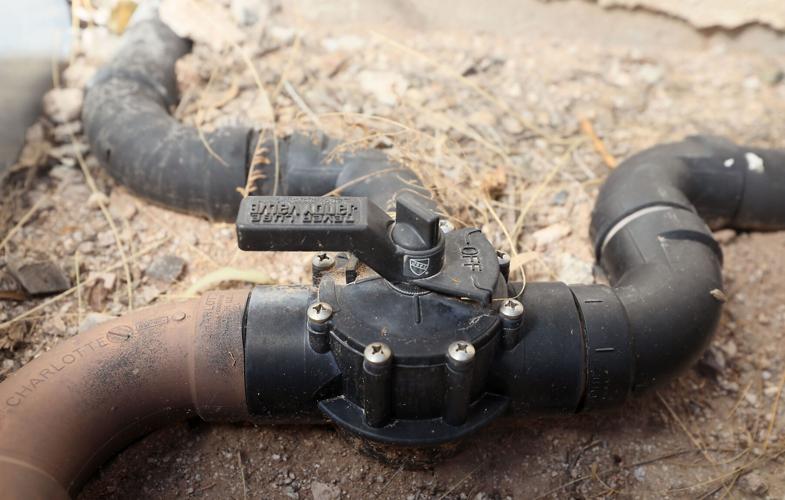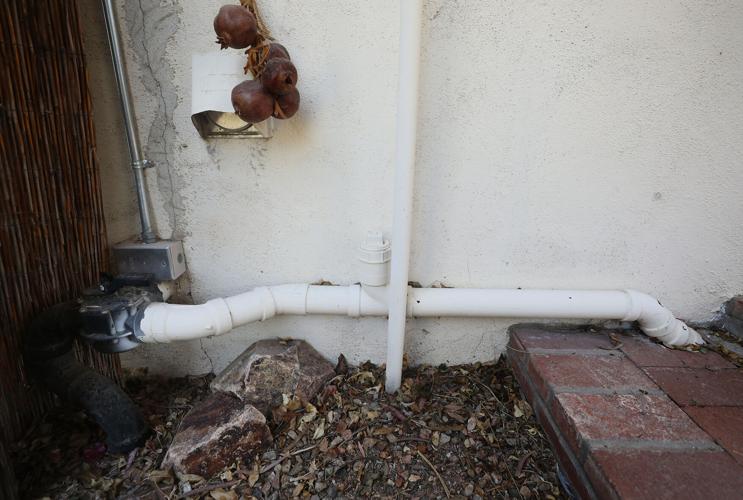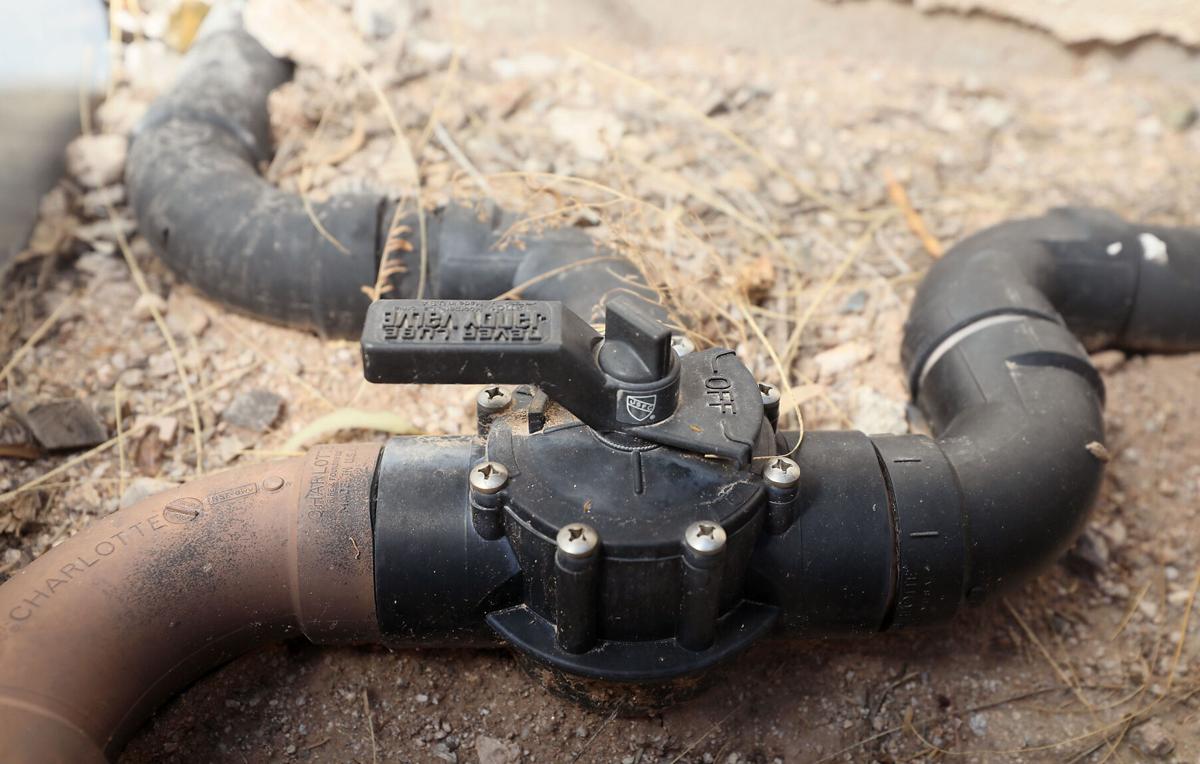Few Tucsonans are reusing household water to irrigate their landscaping, an indication that Tucson’s 12-year-old “gray water” ordinance is failing to help conserve the region’s dwindling resources.
Gray water, or any used water that’s not contaminated with fecal matter, comes from appliances such as the kitchen sink or the shower. If it’s captured going down the drain using a gray water system, it can be reused outside to save upward of 30,000 gallons of water each year in the typical household.
Tucson gained national attention for incentivizing its use through a 2010 policy that requires all new homes to have a special “stub out” — or three-way pipe that allows a gray water system to be easily installed without extra plumbing work — and offers residents $1,000 to buy the needed equipment.
But a recent city survey of residents whose homes were subject to that policy shows the initiative has had virtually no impact in the community.
Only 28 of the nearly 500 Tucsonans surveyed said they use gray water, for example, and less than 1% have taken advantage of the $1,000 rebate. About a third hadn’t even heard of gray water before taking part in the study.
“I was around when this particular ordinance was discussed, put forward and passed, and I too am a bit disappointed that we haven’t had much more success with it,” said Mayor Regina Romero, who was a City Council member when the policy was adopted. “I want to make sure we’re exploring any shortcomings that are possibly not allowing for this program to grow.”
City staff said they had a sense the ordinance was failing, but the recent survey marks the first time Tucson’s gray water policy has been reviewed since it was passed 12 years ago.
It’s one of multiple studies that have exposed major flaws in Tucson’s water policies over the past six months: A recently published review of a separate 2010 ordinance, which requires businesses to use rainwater for at least 50% of their landscaping needs, showed the city had failed to enforce that policy for years.
Because the gray water ordinance is an incentive rather than a requirement for homeowners, city staff said its failure is the result of Tucsonans not being aware that the policy exists — despite it being in place for over a decade.
“It was pretty stark for us that a barrier to the success of the ordinance is the lack of awareness and information about gray water — their homes’ capabilities and the resources, the rebates, the workshops, etc. — that we have available for them,” said James MacAdam, an administrator for Tucson Water.

A gray water system pipe brings water from a shower into the backyard to water a bamboo tree at the Tucson home of Chris Wendel.
MacAdam’s plan to fix the issue isn’t fully fleshed out, but he said it will include outreach to over 6,000 homes built after 2010 in order to let owners know their houses have gray water plumbing and that they can receive cash to have a system installed.
Tucson might also work with homebuilders to get the word out and address some other more technical issues with the ordinance, like gray water piping being hard to access on some properties.
The policy doesn’t dictate where homebuilders should install the gray water outlet, for example, so if it’s placed far away from the landscaping or underground — where residents will need a pump to access it — it’s less likely Tucsonans will go through the trouble of using the system.
“Ideally it’s set up for gravity feed. For instance, when you’re washing dishes you could switch the water to the regular sewage system or to the gray water system, which lets it flow outside of your house where you can apply it to plants,” said Councilman Kevin Dahl. “I think it’s important that we try to get people doing this because 30% of our drinking water goes directly into landscape use. If we can use it functionally in our homes or businesses, that’s a win.”
If MacAdam convinces even a third of Tucson homeowners with gray water plumbing to start using it, the effort could save more than 60 million gallons of drinking water annually in homes built after 2010 alone.
Owners of older homes can also take advantage of the policy. Any house connected to Tucson Water can get the $1,000 rebate to install their own equipment, so the city’s outreach initiative could have an even broader water-saving impact if it’s successful.
It might also be an easy sell for Tucsonans who are hoping to save money. Residents like Cyndi Tuell, who already collect gray water, said the practice has slashed their monthly water bills and made landscaping more affordable.

A wall of vines is watered by a gray water system at the home of Chris Wendel.
“We moved into a house that didn’t have any vegetation in the yard, so all of our plants needed to be established, which was a huge water use and expense for us to consider,” said Tuell, who lives in a century-old home and wasn’t aware of the gray water rebate, so she built a homemade system that collects water from her washing machine. “When we realized how simple it was to use a washer, we could water almost everything in our yard without having to use any fresh water.”
Chris Wendel, a midtown resident and epidemiologist at the University of Arizona, echoed Tuell’s point about affordability.
He said the only financial drawback is the cost of special laundry detergent that’s formulated to be safe for plants, which is about 50% more expensive than typical detergent, though he added that even the installation of gray water plumbing in his 1940’s home was low-cost.
“Literally, it was so cheap what (the plumber) did. We’re just talking about cutting and putting in the three-way valve, and laying a bit of pipe to a logical outflow place,” Wendel said. “(The system) supports plants that we might have tried to grow anyway, but they’re really healthy, including two bamboo plants that would cost a lot to water with straight city water.”

A gray water system at the home of Chris Wendel includes a pipe which brings water from a washing machine into the backyard to water a few vines.
City officials admit the gray water ordinance is one small piece of the conservation efforts that need to take place in the coming years, despite the massive amounts of water the policy could potentially save.
Still, they said it’s an important step toward meeting more ambitious goals such as becoming a carbon-neutral city by 2030, as well as addressing the ever-shrinking supply of fresh water from the Colorado River.
“We need to be doing everything we possibly can on climate change because there’s no silver bullet, there’s no one magic item,” said Dahl, whose campaign centered on climate initiatives. “(The gray water ordinance) is a drop in the bucket, both literally and figuratively, but we need to fill our bucket with lots of drops.”
City staff will update council members on the gray water ordinance within the next year. Depending on how much progress is made, officials may revise the ordinance or adopt new strategies to help revive the failing policy.
Photos: Central Arizona Project canal construction in 1979

Construction of the Central Arizona Project Aqueduct in Western Arizona in June, 1979. The canal supplies the Phoenix and Tucson metro areas with Colorado River water.

6/9/1979 Central Arizona Project construction. Photo by Joan Rennick / CitizenConstruction of the Central Arizona Project Aqueduct in Western Arizona in June, 1979. The canal supplies the Phoenix and Tucson metro areas with Colorado River water.

6/9/1979 Central Arizona Project construction. Photo by Joan Rennick / CitizenConstruction of the Central Arizona Project Aqueduct in Western Arizona in June, 1979. The canal supplies the Phoenix and Tucson metro areas with Colorado River water.

Construction of the Central Arizona Project Aqueduct in Western Arizona in June, 1979. The canal supplies the Phoenix and Tucson metro areas with Colorado River water.

6/9/1979 Central Arizona Project construction. Construction of the Central Arizona Project Aqueduct in Western Arizona in June, 1979. The canal supplies the Phoenix and Tucson metro areas with Colorado River water.

6/9/1979 Central Arizona Project construction. Photo by Joan Rennick / CitizenConstruction of the Central Arizona Project Aqueduct in Western Arizona in June, 1979. The canal supplies the Phoenix and Tucson metro areas with Colorado River water.

Construction of the Central Arizona Project Aqueduct in Western Arizona in June, 1979. The canal supplies the Phoenix and Tucson metro areas with Colorado River water.

Construction of the Central Arizona Project Aqueduct in Western Arizona in June, 1979. The canal supplies the Phoenix and Tucson metro areas with Colorado River water.








